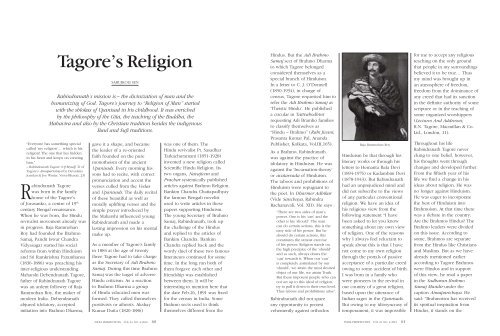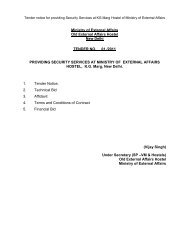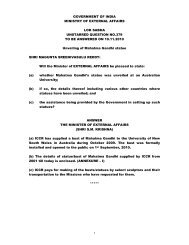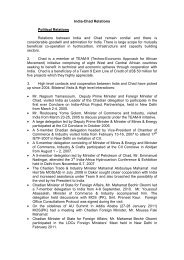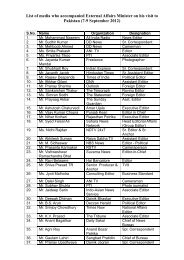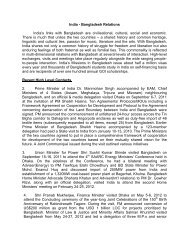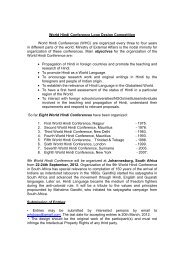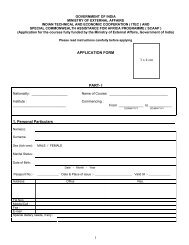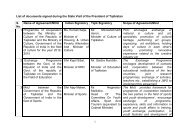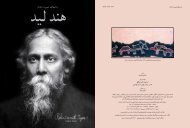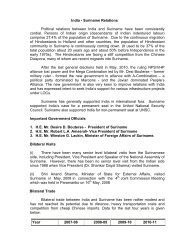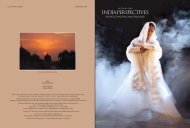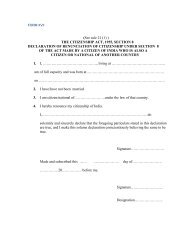IP_ Tagore Issue - Final.indd - high commission of india mauritius
IP_ Tagore Issue - Final.indd - high commission of india mauritius
IP_ Tagore Issue - Final.indd - high commission of india mauritius
Create successful ePaper yourself
Turn your PDF publications into a flip-book with our unique Google optimized e-Paper software.
“Everyone has something specialcalled ‘my religion’… which is hisreligion? The one that lies hiddenin his heart and keeps on creatinghim.”– Rabindranath <strong>Tagore</strong> (Of Myself, Tr <strong>of</strong><strong>Tagore</strong>’s Atmaparichaya by DevadattaJoardan & Joe Winter, Visva-Bharati, 23)Rabindranath <strong>Tagore</strong>was born in the familyhouse <strong>of</strong> the <strong>Tagore</strong>’s<strong>of</strong> Jorasanko, a centre <strong>of</strong> 19 thcentury Bengal renaissance.When he was born, the Hindurevivalist movement already wasin progress. Raja RammohanRoy had founded the BrahmoSamaj, Pandit Iswar ChandraVidyasagar started his socialreforms from within Hinduismand Sri Ramkrishna Paramhansa(1836-1886) was preaching hisinter-religious understanding.Maharshi Debendranath <strong>Tagore</strong>,father <strong>of</strong> Rabindranath <strong>Tagore</strong>was an ardent follower <strong>of</strong> RajaRammohan Roy, the maker <strong>of</strong>modern India. Debendranathabjured idolatory, acceptedinitiation into Brahmo Dharma,<strong>Tagore</strong>’s ReligionSABUJKOLI SENRabindranath’s mission is – the divinization <strong>of</strong> man and thehumanizing <strong>of</strong> God. <strong>Tagore</strong>’s journey to “Religion <strong>of</strong> Man” startedwith the shlokas <strong>of</strong> Upanisad in his childhood. It was enrichedby the philosophy <strong>of</strong> the Gita, the teaching <strong>of</strong> the Buddha, theMahavira and also by the Christian tradition besides the indigenousBaul and Sufi traditions.gave it a shape, and becamethe leader <strong>of</strong> a re-orientedfaith founded on the puremonotheism <strong>of</strong> the ancientUpanisads. Every morning hissons had to recite, with correctpronunciation and accent theverses culled from the Vedasand Upanisads. The daily recital<strong>of</strong> these beautiful as well asmorally uplifting verses and thesimple prayer introduced bythe Maharshi influenced youngRabindranath and made alasting impression on his mentalmake up.As a member <strong>of</strong> <strong>Tagore</strong>’s familyin 1884 at the age <strong>of</strong> twentythree <strong>Tagore</strong> had to take chargeas the Secretary <strong>of</strong> Adi BrahmoSamaj. During this time BrahmoSamaj was the target <strong>of</strong> adverseHindu criticism. As a reactionto Brahmo Dharma a group<strong>of</strong> Hindu educated men wasformed. They called themselvespositivists or atheists. AkshayKumar Dutta (1820-1886)was one <strong>of</strong> them. TheHindu revivalist Pt. SasadharTarkachuramani (1851-1928)invented a new religion calledScientific Hindu Religion. Itstwo organs, Navajivan andPrachar systemically publishedarticles against Brahmo Religion.Bankim Chandra Chattapadhyaythe famous Bengali novelistused to write articles in thesepapers supporting Hinduism.The young Secretary <strong>of</strong> BrahmoSamaj, Rabindranath, took upthe challenge <strong>of</strong> the Hindusand replied to the articles <strong>of</strong>Bankim Chandra. BankimChandra replied back and thewordy duel <strong>of</strong> these two famouslitterateurs continued for sometime. In the long run both <strong>of</strong>them forgave each other andfriendship was establishedbetween them. It will beinteresting to mention here thatthe date Feb.26, 1891 was fixedfor the census in India. SomeBrahmo sects used to thinkthemselves different from theHindus. But the Adi BrahmoSamaj sect <strong>of</strong> Brahmo Dharmato which <strong>Tagore</strong> belongedconsidered themselves as aspecial branch <strong>of</strong> Hinduism.In a letter to C. J. O’Donnell(1850-1934), in charge <strong>of</strong>census, <strong>Tagore</strong> requested him torefer the Adi Brahmo Samaj as‘Theistic Hindu’. He publisheda circular in Tattvabodhinirequesting Adi Bramho familiesto classify themselves as“Hindu – Brahmo” (Rabi Jivani,Prasanta Kumar Pal, AnandaPublisher, Kolkata, Vol.III,165).As a Brahmo, Rabindranathwas against the practice <strong>of</strong>idolatory in Hinduism. He wasagainst the ‘Incarnation-theory’or avatarvada <strong>of</strong> Hinduism.The taboos and prohibitions <strong>of</strong>Hinduism were repugnant tothe poet. In Dharmer Adhikar(Vide Sanchaya, RabindraRachanavali, Vol. XII). He says :“There are two sides <strong>of</strong> man’spower. One is his ‘can’ and theother is his ‘should’. The mancan do certain actions, this is theeasy side <strong>of</strong> his power. But heshould do certain actions, thisconstitutes the utmost exercise<strong>of</strong> his power. Religion stands onthe <strong>high</strong> precipice <strong>of</strong> the ‘should’and as such, always draws the‘can’ towards it. When our ‘can’is completely assimilated by our‘should’, we attain the most desiredobject <strong>of</strong> our life, we attain Truth.But these impotent people who cannot act up to this ideal <strong>of</strong> religion,try to pull it down to their own level.Thus taboos and prohibitions arise”.Rabindranath did not spareany opportunity to protestvehemently against orthodoxRaja Rammohan RoyHinduism be that through hisliterary works or through hisletters to Hemanta Bala Devi(1894-1976) or Kadambini Devi(1878-1943). But Rabindranathhad an unprejudiced mind anddid not subscribe to the views<strong>of</strong> any particular conventionalreligion. We have an idea <strong>of</strong>his religious view from thefollowing statement “I havebeen asked to let you knowsomething about my own view<strong>of</strong> religion. One <strong>of</strong> the reasonswhy I always feel reluctant tospeak about this is that I havenot come to my own religionthrough the portals <strong>of</strong> passiveacceptance <strong>of</strong> a particular creedowing to some accident <strong>of</strong> birth.I was born in a family whowere pioneers in the revival inour country <strong>of</strong> a great religion,based upon the utterance <strong>of</strong>Indian sages in the Upanisads.But owing to my idiosyncrasy <strong>of</strong>temperament, it was impossiblefor me to accept any religiousteaching on the only groundthat people in my surroundingsbelieved it to be true… Thusmy mind was brought up inan atmosphere <strong>of</strong> freedom,freedom from the dominance <strong>of</strong>any creed that had its sanctionin the definite authority <strong>of</strong> somescripture or in the teaching <strong>of</strong>some organized worshippers(Lectures And Addresses,R.N. <strong>Tagore</strong>, Macmillan & Co.Ltd., London, 11).Throughout his lifeRabindranath <strong>Tagore</strong> neverclung to one belief, however,his thoughts went throughchanges and developed further.From the fiftieth year <strong>of</strong> hislife we find a change in hisideas about religion. He wasno longer against Hinduism.He was eager to incorporatethe best <strong>of</strong> Hinduism intoBrahmoism. At that time therewas a debate in the country:Are the Brahmos Hindus? TheBrahmo leaders were dividedon this issue. According tosome, Brahmos are separatefrom the Hindus like Christiansand Muslims. But as we havealready mentioned earlieraccording to <strong>Tagore</strong> Brahmoswere Hindus and in support<strong>of</strong> this view, he read a paperin the Sadharan BrahmoSamaj Mandir under thecaption Atmaparichaya. Hesaid: “Brahmoism has receivedits spiritual inspiration fromHindus, it stands on theINDIA PERSPECTIVES VOL 24 NO. 2/2010 60 INDIA PERSPECTIVES VOL 24 NO. 2/2010 61


